Hearst Entertainment (1991), BCI (July 4, 2006), 5 discs, 710 mins plus supplements, 1.33:1 original full frame ratio, Dolby Digital 2.0, Not Rated, Retail: $29.98
Storyboard:
A young prince follows a dream, searches for Camelot, and learns the ways to knighthood.
The Sweatbox Review:
In a survey of the great cartoonists and newspaper strips, Hal Foster and his Prince Valiant creation stand far above most of the pack. Like Alex Raymond, Foster drew in a detailed, classical style that would inspire other cartoonists for decades to come. Foster first tasted fame while working on the Tarzan strip, but in 1937 he got his chance to launch his own leading star for King Features Syndicate. He went on to draw the strip until 1970, and he wrote it until 1980. During that time, his young hero grew from boyhood to becoming a knight with five children (and grandfatherhood would come just a few years later, in 1987). Foster collected numerous awards, including the Reuben, and was always admired by his peers. Even many of the best illustrators wished that they could draw like Hal Foster.
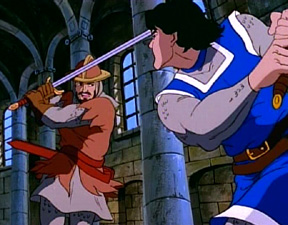
Prior to the animated series, the only other screen appearance for Val was in the 1954 Robert Wagner film, which bore only a passing resemblance to the comic strip. (A British feature was released in 1997.) My first knowledge of the cartoon show came with reading an article about Jesse Santos, a Filipino American cartoonist, which showed some of his conceptual artwork for The Legend Of Prince Valiant. I had never known that the character had been adapted into an animated series, chiefly because I did not have The Family Channel at the time, and it was there that the show ran in prime time. Santos’ art was a revelation. It was beautiful stuff, and it— along with my lifelong interest in comic strip adaptations— made me desperate to see the show. It was only a few months later that BCI announced it was releasing the complete series on DVD, and I was pumped.
Of course, conceptual artwork does not make a show all by itself, but my investigations had suggested that the series had actually turned out very well, garnering a few awards during its two-year run. So, when I received my set in the mail, I plunged into it eagerly.
The Legend Of Prince Valiant encompasses the earliest years portrayed in the strip. In the animated series, Valiant is already a teenager when his father loses his kingdom of Thule and is exiled. Valiant has a dream of the splendor of a place called Camelot. Only a few speak of this place, thinking it possibly a myth; but Valiant’s dream convinces him that Camelot is real— a place of high ideals and chivalry, overseen by the noble King Arthur. Arthur wishes for a New Order to take over the lands, where justice and hope replace violence and despair. Valiant feels almost desperate to find Camelot, and against his parents wishes he leaves them in search of the fabled kingdom. Valiant believes that he will be able to train to become a knight of the round Table, which could allow him to restore his father to the throne of Thule.
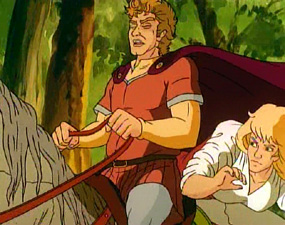
Having not read up on the show’s storylines previously, I was a little surprised at how fast Valiant found Camelot (in Episode 6, appropriately titled The Finding Of Camelot), but he does spend several episodes first forming a friendship with two comrades that will stand by him throughout the series. Arn is a young farmer who is quick to share Valiant’s dream of becoming a knight; and Rowanne is a lovely young lady who decides to aspire to be the first female knight. Together, they find Camelot and are soon to meet the king’s advisor Merlin, knights such as Sir Bryant and Sir Gawain, the fair Queen Guinevere, and King Arthur himself. It is then not long before Valiant comes to own his Singing Sword and comes into conflict with Arthur’s half-sister Morgana.
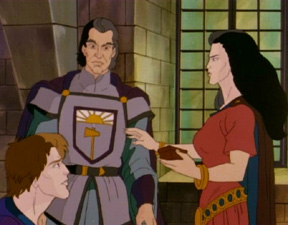
The broad strokes of the series are intriguing enough, but in watching the show I was taken by the serialized nature of the storyline as well. While each episode stands alone, there is a definite progression of the overall story. Not all is right in Camelot. Arthur has enemies within the kingdom, and there are new weapons and threats from abroad. The maturing of Valiant and his friends into warriors becomes crucial to the well-being of Camelot. The first season is comprised of 26 episodes, and it completes a full story arc. Season two, of which this set has the first seven episodes, embarks into new territory. It is notable that this set includes the Humanitas-winning episode The Flute (Episode 32).
I found the storyline enthralling, and was very pleased with the mature but generally family-friendly tone of the stories. The Legend Of Prince Valiant is no doubt an adventure series, but it does carry messages of virtue and optimism, making it a great choice of a show for parents and kids to watch together.

I already mentioned that the preproduction artwork done for the show was very handsome, but how did it turn out on screen? Well, the animation looks great— until anyone moves. I regret to say that the promise of the conceptual art was not fully realized by the rushed animation. Background art is generally attractive and detailed, but the figures are often lacking. The detail is there, but not the draftsmanship. It appears that the animators struggled with the fine points of the character models, resulting in contorting faces that go off model frequently and convey only a limited range of emotions. The animation tries hard to convey a lot of motion, but the limitations of the budget result in stilted animation, and the limitations of the animators make some of the attempts at grace simply appear awkward instead. Add to these problems background characters that are barely drawn, coloring mistakes, and frequent continuity errors from one shot to the next, and you get an amateurish-looking production that tries really hard.
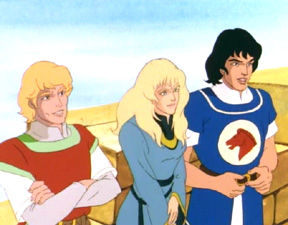
I did appreciate the effort, though. I do wonder, however, if the directors should have maybe better realized the limitations of the budget and animators to make the animation more stylized. Even low budget productions can look great due to skillful economy— the ability of the director to make the most out of money, time, and talent constraints. The Legend Of Prince Valiant fails in this regard, even as the design and writing carry the show to relatively lofty heights.

So, this one gets a mixed response. Overall, I really liked the show for what it did execute, and appreciated what it tried to be even more. The fact that it fell a bit short of its aims visually does not change the fact that it is still entertaining and uplifting.
Is This Thing Loaded?
You can’t tell BCI that this is an obscure show, or that it wouldn’t be worthwhile preparing supplements. Putting other companies to shame once again, BCI and their consultant Andy Mangels put together a nice batch of extras for their first official “Ink and Paint” brand release, continuing the impressive tradition set by their He-Man sets.
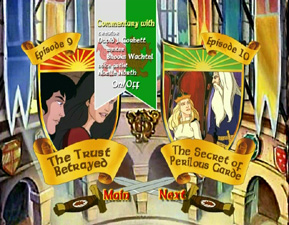
There are two Audio Commentaries with creator/producer David J. Corbett, writer Brooks Wachtel, and voice artist Noelle North. Their pride in the show shines through as they discuss creating The Legend of Prince Valiant and comment on the art and voice talent, as well as why no magic appears in the show. Beware, though— they do go into spoiler territory concerning major developments yet to come.
On the final disc, one can find a set of Interviews with Corbett (6:58), Wachtel (12:58), and comic strip historian Rick Norwood (15:09). Together, that’s over a half-hour of quality material. Corbett discusses the uniqueness of creating a half-hour animated drama for primetime, using dramatic actors rather than “cartoon voices”, creating the Season One story arc, and his pride in winning awards for the show. Wachtel talks about how the show, pitched to him like any other show as being “different from the rest”, really was different. He loved that the show emphasized characterization and sophisticated storytelling. He also goes over some of the restrictions they had, specifically avoiding mythological elements that were present in the comic strip. On the other hand, the show was very liberal in many ways, which amazed Wachtel since it aired on Pat Robertson’s conservative Family Channel. Norwood completes the interviews by offering a history of the comic strip and its creator Hal Foster, as well as commenting on both the 1950s live action movie and the cartoon. I love that stuff! It’s great to see the cartoon placed into the proper context of the Prince Valiant mythos. It would seem an obvious thing to do, but so many cartoon DVD releases miss this type of thing.

The Humanitas-winning episode The Flute gets its own Storyboard Gallery, comprised of a slideshow of about 170 images, set to music from the show. There is another slideshow of Character and Background Art (including more stuff from Jesse Santos). What more could one ask?

DVD-ROM: I’m glad you asked. You can place the fifth disc into your DVD computer drive to access 5 Complete Episode Scripts. Pretty good, eh?
Case Study:
Opening the double-thick keepcase reveals four double-sided discs (4 episodes per side), and one single-sided disc. The latter is disc five, housed on the left side of the case. The others are overlapped in pairs, split between on the right side of the case, and a separate tray. The hubs are a bit tight, so be careful trying to extract the discs. There are a few inserts included, comprised of a nice episode guide pamphlet with images from each episode, a separate promo for BCI’s Hearst sets, and a Funimation catalog. The case is covered with an identical slipcover that slips over the top.
Ink And Paint:
Ouch. We probably cannot blame BCI completely, as they likely have to use whatever materials they are given, but these transfers are not too good. The picture is flat and jittery, and even occasionally jumpy. The sometimes-quivering quality of the animation itself doesn’t help matters, but there are also fluctuating color levels and frequent physical artifacts (dust, etc.) that show up. I found the show reasonably watchable on a 31” screen, but it got ugly on a 51” HDTV screen. Whether the fault of the materials used, or how they were compressed, this is far from reference quality.
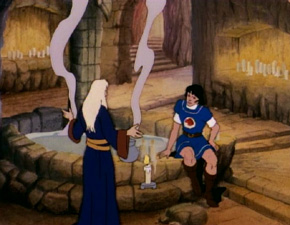
Scratch Tracks:
The 2.0 track gets the job done, but does not overly impress. The range is quite narrow, and there is little “pop” to the voices, music or sound effects. One certainly cannot place blame on the voice talent for any audio defects, though. This show has a stellar cast that is well directed. Robby Benson is nicely earnest as Valiant, Allan Oppenheimer gives authority to Merlin, and Efrem Zimbalist, Jr. portrays Arthur with both majesty and humanity. Other formidable talents such as Patty Duke, Tony Jay, and Ron Perlman also show up to give weight to the voice acting.
And I would personally like to thank the producers for their decision to not have everyone speak in Medieval English.
No subtitles are offered.
Final Cut:
Tough call here. There are so many DVD box sets coming out, that you have to really believe in a show to want to buy it despite it having lacking animation and subpar video. For myself, while I cannot deny some disappointment in the visual area, I still loved the show overall and appreciated the well-produced supplements. BCI does wonderful work on producing their cartoon sets, and they have the gratitude of many fans. Hopefully they can acquire better materials for some of their future releases.
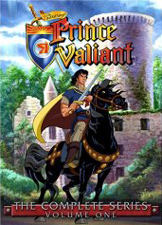 | ||
 |






